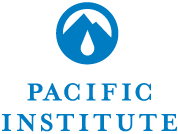 Earlier today, the Pacific Institute and the NRDC held a media call in anticipation of the final snow survey tomorrow. During the call, Peter Gleick, director of the Pacific Institute, discussed the science and hydrology of the drought, Doug Obegi, staff attorney with the NRDC discussed the allocations and how water is used in California, and Steve Fleischli with the NRDC discussed actions the state and its residents could be taking to address the currnet drought and prepare for future ones.
Earlier today, the Pacific Institute and the NRDC held a media call in anticipation of the final snow survey tomorrow. During the call, Peter Gleick, director of the Pacific Institute, discussed the science and hydrology of the drought, Doug Obegi, staff attorney with the NRDC discussed the allocations and how water is used in California, and Steve Fleischli with the NRDC discussed actions the state and its residents could be taking to address the currnet drought and prepare for future ones.
The following is a transcript of the media call.
Peter Gleick, Pacific Institute
 I’m Peter Gleick; I’m director of the Pacific Institute in Oakland, California, which is an independent research and policy group working on global water issues. I’m going to talk about the nature of the science and hydrology of the current drought and give a quick overview of where we are.
I’m Peter Gleick; I’m director of the Pacific Institute in Oakland, California, which is an independent research and policy group working on global water issues. I’m going to talk about the nature of the science and hydrology of the current drought and give a quick overview of where we are.
I am going to make four points. First of all the drought in California is extremely severe and we are now at the end of what we consider the rainy season in California. There may be a few more weeks of some precipitation but we’re in an extreme drought.
The second point is that the drought is not only severe but it’s extensive. One hundred percent of the state is considered to be in some degree of water stress. About three-quarters of the state is in what’s called extreme or extraordinary drought, and it looks like there’s no relief in sight, even with the recent bit of precipitation we’ve seen in the last week or so.
[pullquote align=”left|center|right” textalign=”left|center|right” width=”30%”]”If you want to ask if climate change caused the current drought, that’s the wrong question. The question really is how is climate change influencing the extremes that California experiences normally. As the Intergovernmental Panel on Climate Change (IPCC) report that has just been released in Yokohama, Japan in the last day or so has indicated, climate change is now influencing our extreme events and will continue to do so.” — Peter Gleick[/pullquote]The third point is drought is measured by many different things in California. In part, it’s a combination of the water that’s available to us and in part it’s a combination of the water that we demand as a society. I would note that even in a normal year, the demand for water exceeds the supply. We’re reaching what I call peak water in California, and by no means is this a normal year. This is an extremely dry year, measured by many different things. Measured by snowpack, measured by reservoir storage levels, measured by soil moisture, measured by the water to be delivered to users, and some of the other speakers will address some of these issues.
But in particular, the snowpack measurement on April 1st, that is tomorrow, is often considered a key measure of where we are. It’s an indication going back many, many years for how much water is available in the spring and the summer. By any measures, our snowpack is low. The current estimate of snowpack is about 30% of normal, one-third of normal. That is, we’ve lost 70% of our normal expected snowpack. It’s possible that number will go up in the next couple of days with the last bit of storms, and we’ll have the exact measurements for April 1st tomorrow, but expect it to be really abnormally low.
Reservoir levels are also very low. This is not the first year of the drought; this is the third year of low precipitation and our major reservoirs are hovering around half of normal. Soil moisture is also extremely low, and all of these things combine to cut deliveries to users, to different degrees, and some of the later speakers will talk about the differences in deliveries to different kinds of users.
And my fourth point is a quick comment about climate change. We know that climate change is contributing to the current drought in the following ways: Not only has precipitation has been low, but we’ve experienced very high temperatures in California in the last several years, and higher temperatures alone mean higher evaporative loss from our reservoirs, more evaporative loss from our soils, more demand for water by vegetation, and decreases in snowpack and increases in rain – a change in the ratio, so higher temperatures have affected that. We’ve seen higher sea levels over the last century that push more salt into the Delta; that requires that we push more fresh water into the Delta to keep salinity levels low so that water agencies can get higher quality water, and that’s going to be a challenge that’s growing in coming years.

If you want to ask if climate change caused the current drought, that’s the wrong question. The question really is how is climate change influencing the extremes that California experiences normally. As the Intergovernmental Panel on Climate Change (IPCC) report that has just been released in Yokohama, Japan in the last day or so has indicated, climate change is now influencing our extreme events and will continue to do so.
- Update on the California Drought – March 31, 2014, blog post by Peter Gleick at the Significant Figures Blog
Doug Obegi, Natural Resources Defense Council
 I’m Doug Obegi, I am an attorney with the Natural Resources Defense Council, and I want to talk briefly about how we use water in California. And particularly give you a little bit of context for the allocation announcement for the State Water Project and the federal Central Valley Project, which we’re expecting tomorrow.
I’m Doug Obegi, I am an attorney with the Natural Resources Defense Council, and I want to talk briefly about how we use water in California. And particularly give you a little bit of context for the allocation announcement for the State Water Project and the federal Central Valley Project, which we’re expecting tomorrow.
In a normal year, California’s snowpack holds about 15 MAF of water which is more than all the California cities used in 2010. It’s a lot of water. Obviously, this is not a normal year. That snowpack is important, not just for the state and federal water projects, the State Water Project and the Central Valley Project, but for water users around the state. California has more than 8 million acres of irrigated lands, and in a normal year, that accounts for 75-80% of all the human diversions for water. A lot of that does depend on snowpack, whether that’s farmers along the Sacramento River or in the San Joaquin Basin, and again for those exports from the two big projects.
The two big projects, the State Water Project and the Central Valley Project, only account for about 8% of the state’s water supply, which doesn’t sound like a lot, but it’s critically important for some parts of the economy, particularly in Southern California where it provides about one-third of the supply, and in Kern County where it provides about one-third of the supply for agriculture.
[pullquote align=”left|center|right” textalign=”left|center|right” width=”30%”]”Drought and not environmental restrictions are really the cause of the low water allocations in this incredibly dry year. Both under state and federal law, environmental protections for salmon and native fish are much weaker in the dry years, acknowledging that water is scarce. There’s been no water supply restrictions to protect Delta smelt this year, and while there have been some limited restrictions to protect migrating salmon and steelhead, those are a small tiny fraction of the total amount of water that would otherwise be available this year.” — Doug Obegi[/pullquote]I think the key thing to talk about here though is that not everyone’s going to be affected equally by the this drought, and that’s really a function both of where folks get their water, how much water they’ve saved in the past, and how senior their water rights are. California’s water rights system is really seemingly inequitable – the first in time, first in right system – so there will be some farmers who will get water from the Central Valley Project who will get 40% of their contractual supply while others get zero. Imperial Valley farmers will get one hundred percent of their allocation from the Colorado River and farmers for the State Water Project, they have all of their contractors who will be getting a zero allocation, or at least that was the initial allocation. They do have some senior water rights holders on the Feather River who will get 50% of their nearly 1.2 MAF of water each year.
For the Central Valley Project, it’s a similar situation. It’s even more complicated where you have senior water rights holders like the San Joaquin River Exchange Contractors who will get 40% and senior water rights holders on the Stanislaus River who will get 60% of their maximum allocation. Municipal and industrial customers like the Santa Clara Valley Water District will get a 50% allocation from the Central Valley Project.
And with that limited amount of snowpack and water supply, water contractors are going to have to turn to other sources of water. Part of the reason why Southern California is in such good shape going into this drought it that they have diversified their supply, they’ve built local storage to save up water from the last several years, and they’ve reduced how much water they use through investments in conservation. Other parts of the state are going to really depend on groundwater. And as you’ve seen, some parts of the state have really well managed groundwater basins, and other parts really have significant overdraft, and we expect to see some really significant overdrafting of the aquifers in parts of the state, including in the Central Valley. In a typical year, you’d see a lot of water transfers, but there’s just so little water in the system, that transfers are going for exorbitant prices when they are available at all.
The last point I want to emphasize is that drought and not environmental restrictions are really the cause of the low water allocations in this incredibly dry year. Both under state and federal law, environmental protections for salmon and native fish are much weaker in the dry years, acknowledging that water is scarce. There’s been no water supply restrictions to protect Delta smelt this year, and while there have been some limited restrictions to protect migrating salmon and steelhead, those are a small tiny fraction of the total amount of water that would otherwise be available this year.

In addition, the State Water Resources Control Board has permitted increased pumping and relaxed a lot of those environmental protections this year, so we’re actually getting more water for water contractors and less for the environment than the rules would typically allow. And finally, just note that under our settlement to restore the San Joaquin River, restoration flows have ceased completely because the conditions are so dry in the river. So ultimately it is drought and not environmental protections that are the cause of these low water allocations, and everyone’s going to be struggling, although not to the same degree.
- Doing the Math on California Water Solutions: Dams Can’t Compete with 21st Century Options, blog post by Doug Obegi at the NRDC Switchboard blog
Steve Fleischli, Natural Resources Defense Council
 This is Steve Fleischli, I am the water program director at NRDC. I’m going to talk about response priorities, and while we can’t make it rain or even snow, we can prepare for even drier days ahead. And it’s really important to recognize that everyone has a role to play in that. Our federal, state, and local leaders, as well as every resident, whether that’s on our farms or in our cities or our homes.
This is Steve Fleischli, I am the water program director at NRDC. I’m going to talk about response priorities, and while we can’t make it rain or even snow, we can prepare for even drier days ahead. And it’s really important to recognize that everyone has a role to play in that. Our federal, state, and local leaders, as well as every resident, whether that’s on our farms or in our cities or our homes.
At the agricultural level, there are really huge opportunities to maximize water smart strategies, especially considering that the farming in California accounts for 80% of California’s water use. Irrigation systems are the first place to start. According to the USDA, over half of the acres in California still use the old outdated gravity-based systems to irrigate crops – basically flood and furrow techniques. These systems lose huge amounts of water to evaporation and spillage, yet in other heavily irrigated states like Nebraska, Kansas, and Texas, fewer than 20% of farm acreage uses gravity irrigation, and there’s no reason that California, the tech capital of the world, should lag so far behind.
Upgrading farm irrigation infrastructure has the potential to save hundreds of billions of gallons of water each year. But we need to focus on a single goal, more crop per drop. Modern irrigation technologies can deliver what is needed to each crop and when it is needed most to maximize yield. The state can help facilitate, incentivize, and in part finance these kinds of upgrades, which include more efficient irrigation practices such as drip irrigation, precise irrigation scheduling, soil moisture monitoring, and similar practices to improve water use efficiency.
[pullquote align=”left|center|right” textalign=”left|center|right” width=”30%”]”At the agricultural level, there are really huge opportunities to maximize water smart strategies, especially considering that the farming in California accounts for 80% of California’s water use. Irrigation systems are the first place to start.” –Steve Fleischli [/pullquote]We also need more of our agricultural water districts to create water management plans, and to measure their water deliveries. These are a critical first step, because as we all know, you can’t manage what you don’t measure. They are required to do this under the law as well, but that law is really not enforced, and in fact, only 38% of agricultural water districts have submitted the required management plans that were due more than a year ago.
We also need a comprehensive state water bond to provide sufficient funding on the scale that California needs to address this problem. The state has the opportunity this year to pass a water bond that invests in significant efficiency and conservation measures that will put us ahead of the game over the long term. The bond should also incentivize local self reliance in a way that will transform how we view stormwater and recycled water and their ability to augment local water supply.
At the city level, we can all benefit by more green infrastructure. Pocket parks, rain gardens, rain barrels, and cisterns so that when it does rain, we capture it and reuse it, instead of letting it pour off our city streets. The water can then be stored and used or filtered into the ground to replenish groundwater supplies. Cities throughout California can promote green infrastructure through all new development plans and incentivize businesses to use green infrastructure in and around existing structures.
We also need to expand water recycling and reuse. Cities are increasingly using recycled water that is thoroughly treated waste water to irrigate parks and lawns and recharge groundwater supplies. Cities and utilities throughout the state must provide expanded water recycling programs. We can implement other measures, too, like improved water metering and improved pricing to encourage conservation.
And finally, there are also many tools that homeowners and businesses can use. For example, incentives for water smart technologies and water efficient technologies like water sense, toilets, showerheads, and energy star clothes washers and dishwashers dramatically reduce per person water consumption. State and local agencies can establish or expand rebates and tax holidays for consumers switching to these types of products, and building codes can also be upgraded to strengthen these requirements for new development.
We can also expand native landscaping conversion programs. Fifty percent of water for homes in Southern California goes to our lawns. The cash for grass programs pay people to convert their lawns to drought tolerant and native plants. The City of Long Beach, for example, the best in the state with the highest incentive, provides $3 per square foot to replace grass lawns with more efficient landscaping. Other cities can follow Long Beach’s lead.
All of these solutions add up to big water savings that will benefit California in good weather, and in bad, and in low snowpack years, just like this one.
- Viewpoints: A prescription to prepare for drought, commentary in the Sacramento Bee by Steve Fleischli
——————————————–
Get the Notebook blog by email and never miss a post!
- Sign up for daily emails and get all the Notebook’s aggregated and original water news content delivered to your email box by 9AM. Breaking news alerts like this one, too. Sign me up!
 Maven’s Notebook
Maven’s Notebook
constantly watching over the world of California water

